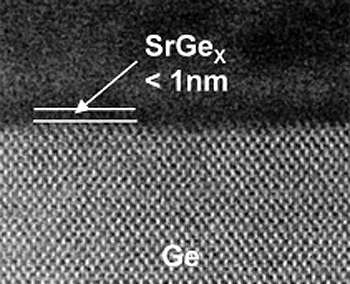Intel Granted Patent for Germanium Nanowire Transistors
Intel was granted a patent that covers the use of germanium as a material choice for compound semiconductors that promise faster processors and reduced power consumption.
Submitted as a patent application in April of 2010, the company first discussed a related invention at the 2010 International Electron Devices Meeting. Intel disclosed that it had developed P-channel transistors made from germanium, which the company said could be combined with complementary III-V N-channel transistors to form a suitable CMOS architecture. The focus on germanium is largely due to the fact that it is more mobile than silicon.
The patent itself reveals the use of a "germanium nanowire channel and the SiGe anchoring regions [that] are formed simultaneously through preferential Si oxidation of epitaxial Silicon Germanium epi layer." Intel leverages a silicon fin as a "template" to align germanium nanowires on a chip while silicon-germanium anchors are used to mount to a silicon substrate. Germanium is likely to become a much more critical material in chip manufacturing in the future, as such nanowires "provide better control of short channel effects such as sub threshold slop and drain induced barrier lowering," the patent states.
The extensive use of germanium has been discussed by the semiconductor industry for more than a decade, while first sophisticated germanium processors were predicted 15 years ago to arrive in the 2007 - 2008 time frame (similarly, the first graphene processors are now forecast to become available around 2020 - 2025). The history even goes back to 1959, when Jack Kilby built a microchip with germanium, but it was Intel-co-founder Robert Noyce who chose silicon and overcame. Back then, germanium was found to be limited by greater current leakage. Over the past ten years, the interest in germanium as a transistor material has increased significantly and has resulted in developments such as IBM's 500 GHz GPU.
Get Tom's Hardware's best news and in-depth reviews, straight to your inbox.

Douglas Perry was a freelance writer for Tom's Hardware covering semiconductors, storage technology, quantum computing, and processor power delivery. He has authored several books and is currently an editor for The Oregonian/OregonLive.
-
bustapr back_by_demandHang on, wind that back...500GHz CPU?WANT ONE!!!Replyhas resulted in developments such as IBM's 500 GHz GPU.
-
Onus Iirc, germanium was pretty much abandoned in analog circuits because it was much more prone to "thermal runaway" than silicon. Has this issue been solved, or is it simply not relevant? What are the thermal limits on these germanium circuits?Reply -
bustapr Im all up for progress and anything that makes Ivy Bridge's tri-gate transistors better, but how were they granted a patent for something they didnt create and werent the first to use commercially?Reply -
bustapr jtt283Iirc, germanium was pretty much abandoned in analog circuits because it was much more prone to "thermal runaway" than silicon. Has this issue been solved, or is it simply not relevant? What are the thermal limits on these germanium circuits?in nanotech, the length of the bridge in transistors is very small. So small that the currents flow in a straight line from source to drain as opposed to micro wires where the currents ricocheted towards the drains.Reply -
Progress?? How can anyone mention progress when a private company is granted patent on progress?Reply
